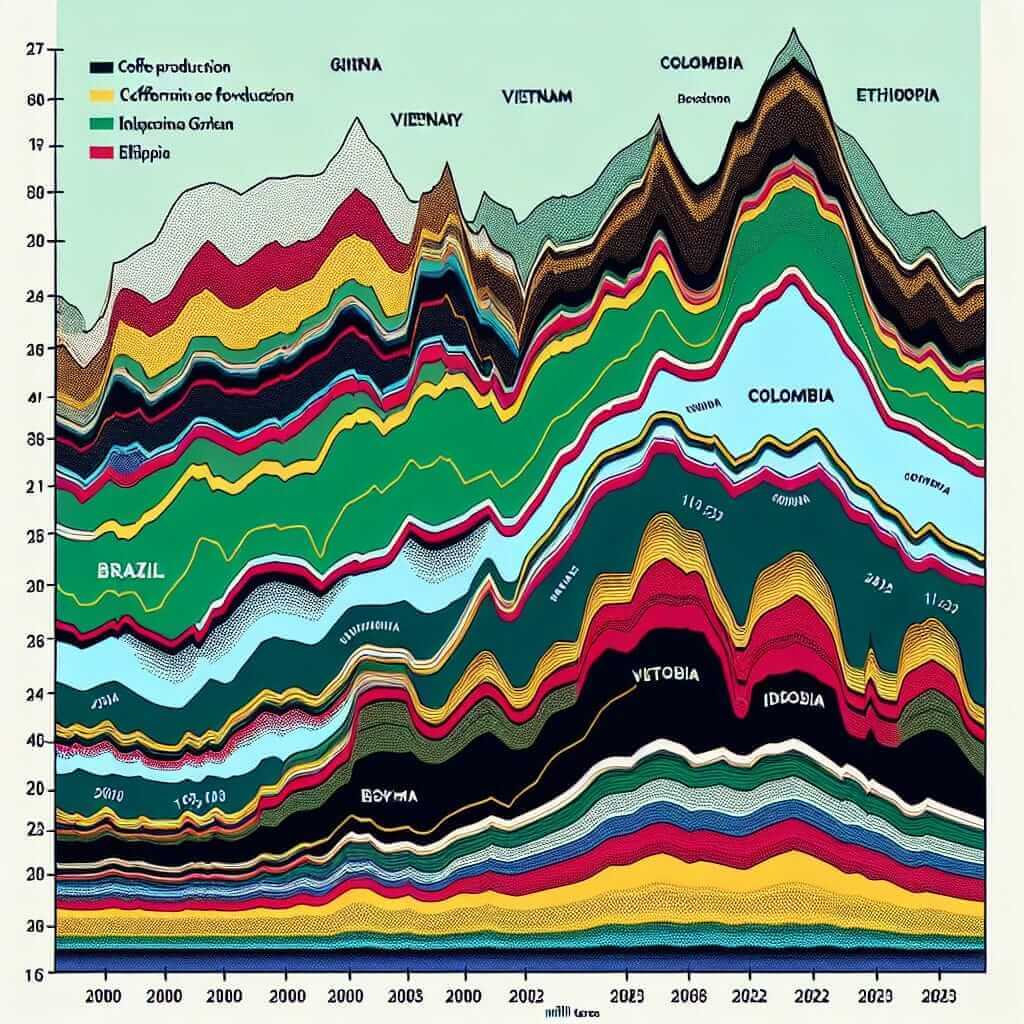The topic of “Coffee Production in Top Five Countries (2000-2023)” has emerged frequently in IELTS writing task 1. Analyzing such data can help you familiarize with task requirements, improve your data interpretation skills, and refine your essay structuring abilities. This essay will explore various facets of the coffee production landscape: analyzing data, highlighting shifts, and understanding underlying trends.
IELTS Writing Task 1 Analysis
Writing task 1 in the IELTS exam typically includes interpreting data from graphs, charts, tables, or diagrams. You are expected to summarize and compare information, identify trends, and report key features. Given the span from 2000 to 2023, analyzing coffee production in top five countries would involve understanding both historical trends and recent developments.
Sample Task
“In the graph/table below, the coffee production (in million tonnes) of the top five coffee-producing countries from 2000 to 2023 is shown. Summarize the information by selecting and reporting the main features, and make comparisons where relevant.”
Data Analysis
Breakdown of the Data
We will first create the data set for the top five coffee-producing countries:
- Brazil
- Vietnam
- Colombia
- Indonesia
- Ethiopia
Using available resources and data, here is an example table:
| Year | Brazil | Vietnam | Colombia | Indonesia | Ethiopia |
|---|---|---|---|---|---|
| 2000 | 1.2 | 0.4 | 0.6 | 0.5 | 0.2 |
| 2005 | 1.5 | 0.65 | 0.55 | 0.55 | 0.22 |
| 2010 | 1.9 | 1.10 | 0.7 | 0.6 | 0.3 |
| 2015 | 2.3 | 1.5 | 0.8 | 0.65 | 0.4 |
| 2020 | 2.5 | 1.75 | 0.9 | 0.7 | 0.5 |
| 2023 | 2.8 | 2.0 | 0.95 | 0.8 | 0.55 |
Graph Interpretation
- Brazil consistently dominates coffee production, increasing steadily from 1.2 million tonnes in 2000 to 2.8 million tonnes in 2023.
- Vietnam shows significant growth, especially notable from 2010 onwards, rising from 1.1 million tonnes to 2.0 million tonnes by 2023.
- Colombia has moderate growth, with minor fluctuations.
- Indonesia and Ethiopia show gradual increases, with Ethiopia having the least production among the five.

Writing Sample
Let’s proceed to write a sample essay based on the data above:
Essay Sample
The table illustrates the coffee production figures (in million tonnes) of the top five coffee-producing countries from 2000 to 2023. It is evident that Brazil consistently produced the highest amount of coffee, with its production rising from 1.2 million tonnes in 2000 to 2.8 million tonnes in 2023, marking a significant growth.
Vietnam also witnessed a remarkable increase, especially post-2010 where its production nearly doubled from 1.1 million tonnes to 2.0 million tonnes by 2023. This indicates Vietnam's growing prominence in the global coffee market.
Colombia's production data, while showing growth from 0.6 million tonnes in 2000 to 0.95 million tonnes in 2023, experienced minor fluctuations, unlike the steady rises seen in Brazil and Vietnam.
Indonesia and Ethiopia maintained lower production levels compared to the top three. Indonesia's production increased moderately from 0.5 million tonnes in 2000 to 0.8 million tonnes in 2023. Ethiopia, while starting with the least production figures, showed a steady increase, almost tripling its production from 0.2 million tonnes to 0.55 million tonnes over the same period.
In summary, while Brazil and Vietnam emerged as the leading producers with substantial increases in their outputs, other countries like Colombia, Indonesia, and Ethiopia also demonstrated steady but less pronounced growth. This data reflects the dynamic and evolving nature of global coffee production dynamics over the two decades.Word Count: 203
Key Considerations
Vocabulary and Grammar
When writing about data:
- Use comparative structures: “higher than”, “lower than”, “as much as”, “less than”.
- Descriptive adverbs/adjectives: “steadily”, “significantly”, “moderately”.
- Nouns and verbs describing trends: “increase”, “decrease”, “fluctuate”, “rise”, “fall”.
Critical Vocabulary
- Consistently /kənˈsɪstəntli/ (adv) -In a constant and predictable manner.
- Fluctuation /ˌflʌktʃuˈeɪʃn/ (n) -An irregular rising and falling in number or amount.
- Prominence /ˈprɒmɪnəns/ (n) -The state of being important or famous.
- Steady /ˈstɛdi/ (adj) -Firmly fixed, constant, regular.
- Remarkable /rɪˈmɑːkəbl/ (adj) -Worthy of attention; striking.
Conclusion
Writing a compelling essay for IELTS writing task 1 involves mastering the interpretation of data, using varied vocabulary, and maintaining a coherent structure. When addressing topics like “Coffee Production in Top Five Countries (2000-2023)”, leveraging data effectively to illustrate trends and comparisons is crucial. Aim for clarity, accuracy, and proper use of language to achieve a Band 7+ score.